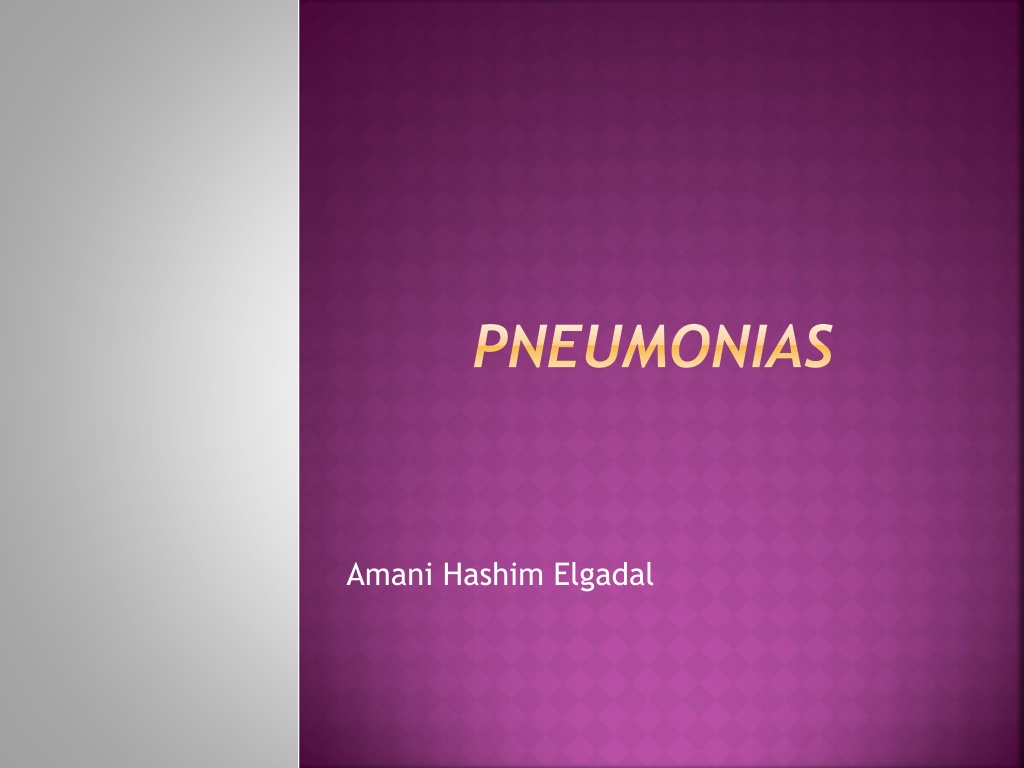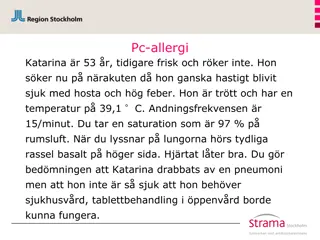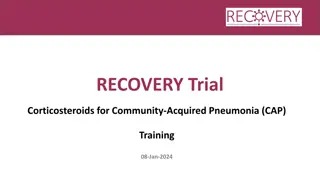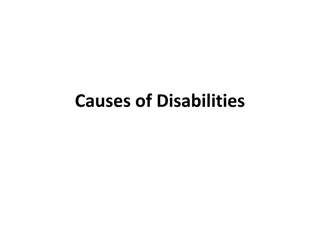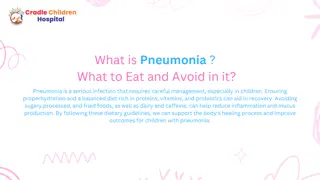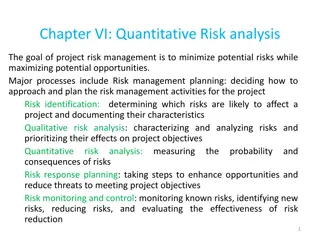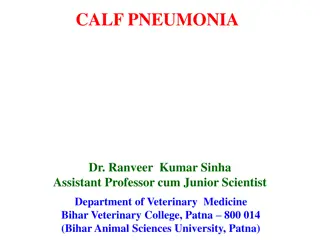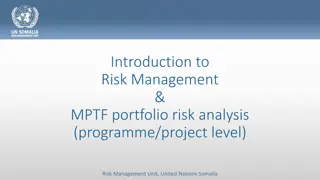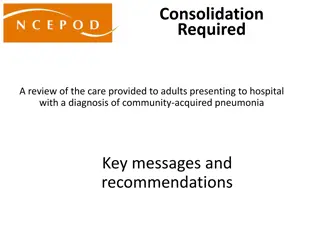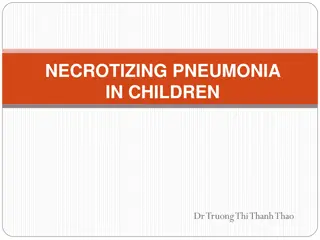Pneumonia: Causes, Classification, and Risk Factors
Pneumonia is an infection of the lower respiratory tract that can be classified anatomically and etiologically. The common causes include bacterial, viral, and fungal pathogens, as well as aspiration pneumonia. Factors such as immune deficiency, overcrowding, and poor hygiene can increase the risk of pneumonia. This presentation covers the definition, classifications, predisposing factors, risk factors, and common pathogens associated with pneumonia in different age groups.
Download Presentation

Please find below an Image/Link to download the presentation.
The content on the website is provided AS IS for your information and personal use only. It may not be sold, licensed, or shared on other websites without obtaining consent from the author.If you encounter any issues during the download, it is possible that the publisher has removed the file from their server.
You are allowed to download the files provided on this website for personal or commercial use, subject to the condition that they are used lawfully. All files are the property of their respective owners.
The content on the website is provided AS IS for your information and personal use only. It may not be sold, licensed, or shared on other websites without obtaining consent from the author.
E N D
Presentation Transcript
PNEUMONIAS Amani Hashim Elgadal
OBJECTIVES By the end of this lecture ,the students will be able to: Define & classify pneumonia Know the common causes of pneumonia Assess the clinical presentation of pneumonia Outline its management plan
DEFINITION: Is infection of lower respiratory tract and air ways, parenchyma, and consolidation of the alveolar spaces. inflammation of lung parenchyma.
CLASSIFICATIONS: 1- anatomical classification: *Lobar pneumonia: consolidation involve all or part of lobe. *Bronchopneumonia: consolidation involve scatter lobules. *Interstitial pneumonia: inflammatory infiltrate involves mainly interstitial spaces between alveoli.
2- etiological classification: *bacterial: -gram +ve: strept. Pneumoniae and pyogen staph. -gram ve: H. influenza, klebsiella, pseudomonas, mycobacterium tuberculosis. *Viral: RSV, parainfleunza and infleunza, adenovirus, CMV. *Fungal: histoplasma, candida albicans *Aspiration pneumonia: aspiration of foreign body, lipoid substance, hydrocarbons as kerosene and aspiration of amniotic fluid. *Loeffer s syndrome
3- according to underlying cause: *primary pneumonia: occur in healthy baby *secondary pneumonia: in baby debilitated by another disease
PREDESPOSING FACTORS: Immune deficiency Foreign body Increased pulmonary blood flow eg large left to right shunt VSD Congenital anomaly eg cleft palate, tracheo- esophageal fistula anf immotile celia syndrome TB
RISK FACTORS: Low socio-economic state Overcrowding Poor hygiene Vit.A deficiency Malnutrition Low body wt Not breast feed Not vaccenated Endemic desease Smoking Air polution
CAUSES OF INFECTIOUS PNEUMONIA IN DIFRENT AGE GROUP: Age Group Common Pathogens (in Order of Frequency) Newborn Group B Streptococci Gram-negative bacilli Listeria monocytogenes Herpes Simplex Cytomegalovirus Rubella 1-3 months Chlamydia trachomatis Respiratory Syncytial virus Other respiratory viruses 3-12 months Respiratory Syncytial virus Other respiratory viruses Streptococcus pneumoniae Haemophilus influenzae Chlamydia trachomatis Mycoplasma pneumoniae
Age Group Common Pathogens (in Order of Frequency) 2-5 years Respiratory Viruses Streptococcus pneumoniae Haemophilus influenzae Mycoplasma pneumoniae Chlamydia pneumoniae 5-18 years Mycoplasma pneumoniae Streptococcus pneumoniae Chlamydia pneumoniae Haemophilus influenzae Influenza viruses A and B Adenoviruses Other respiratory viruses
In immunocompromised children ,it is caused by opportunistic agents e.g. M. avium complex, fungi as asperagillus histoplasma, pneumocystis carinii, CMV. Children with cystic fibrosis are prone to develop pneumonia with S. aureus, pseudomonas, Children with sickle cell disease have problem with their complement system as well as asplenia, which predispose to infection with encapsulated organisms such as S. pneumonae, H. influenzae ,
PATHOGENESIS: Viral: characterized by accumulation of mononuclear cells in the sub-mucosa and perivascular spaces resulting in partial airway obstruction & present with wheezing and crackles. alveolar type 2 cells may lose its structural integrity and decreased surfactant production a hyaline membrane forms and pulmonary edema may develop.
lobar pneumonia has 4 stages 1ststage which occurs within 24hrs of infection the lung characterized microscopically by vascular congestion and alveolar edema many bacteria and few neutrophils.2ndstage red hepatization (2-3days) so called because of its similar to consistency of the liver, characterized by presence of many erythrocytes, neutrophils desquamated epithelial cells and fibrin within alveoli.3rdstage gray hepatization (2-3days) the lung is gray brown to yellow because of fibrinopurulent exudate, disintegration of of RBCs and hemosiderin. 4thstage resolution is characterized by resorption and restoration of pulmonary architecture. Fibrinous inflammation leads to resolution or to orgnization and pleural adhesions.
Bronchopneumonia patchy consolidation involves one or more lobes usually involves the dependent lung zones the nutrophilic exudate is centered in bronchi and bronchioles with centrifugal spread to adjacent alveoli. Interstitial pneumonia patchy or diffuse inflammation involving the interstitium is characterized by infiltration of lymphocytes and macrophage the alveoli do not contain significant exudate but protein rich hyalline membranes may line the alveolar spaces
PRESENTATION: History: Neworn: rarely cough, commonly present with poor feeding, irritability, tachypnea, retractions, grunting, and hypoxemia. Grunting is due to vocal cord approximation to provide increased positive end expiratory pressure to keep lower airways open. After 1 month of age cough is the most common presenting symptom, grunting is less common but retractions tachypnea and hypoxemia are common and may be accompanied by persistent cough congestion fever irritability and decreased feeding Infants with bacterial pneumonia are often febrile but those with viral or atypical organisms may have low grade fever or be afebrile.the parent may also complain that child has wheez or noisy breathing
Toddlers and preschoolers most often present with fever, cough (productive or not), tachypnea, and congestion. They may have some vomiting, particularly postttusive emesis. Hx of proceeding upper respiratory tract infection is common. Older children and adolescents may also present with fever, cough (productive or not), congestion, chest pain, dehydration, and lethargy. Adolescents may have other constitutional symptoms such as head ache, pleuritic chest pain, and vague abdominal pain, vomiting, diarrhea, and otalgia-otitis.
Travel hx is important it may reveal exposure to pathogen more common to specific geographic area. Any exposure to TB should be determined also exposure to birds (pisttacosis) bird droppings(histoplasmosis) bats( histoplasmosis) and other anemals. In children with recurrent pneumonias carful hx is needed to determine underlying cause eg innate or aquired immune deficiency, anatomic defect, or genetic disease(cystic fibrosis or ciliary dyskinasia).
Examination: Observation of the infant is the most important part of the examination does the child look sick!! look for signs of respiratory distress( nasal flaring, subcostal intercostals and suprasternal retraction, tachypnea, grunting) Tachypnea is the most sensitive and specific sign of pneumonia Tachypnea as defined by WHO as follows:
Age Respiratory Rate (breaths/min ) Indication of severe infection (breaths/mi n) < 2 months > 60 >70 2 to 12 months > 50 12 months to 5 years > 40 >50 Greater than 5 years > 20
out---breathing---in Lower chest wall indrawing: with inspiration, the lower chest wall moves in Nasal flaring: with inspiration, the side of the nostrils flares outwards
Assess O2 saturation by pulse oximetry Temp. Pulse Auscultation may be difficult in infants and young children, even if crackles are present as stand alone physical examination findings is neither sensitive nor specific to diagnose pneumonia.
PNEUMONIA SEVERITY ASSESSMENT: Mild Temperature <38.5 C RR < 50 breaths/min Mild recession Taking full feeds Severe Temperature >38.5 C RR > 70 breaths/min Moderate to severe recession Nasal Flaring Cyanosis Intermittent Apnea Grunting Respirations Not feeding Temperature >38.5 C RR > 50 breaths/min Severe difficulty in breathing Nasal Flaring Cyanosis Grunting Respirations Signs of dehydration Infants Older Children Temperature <38.5 C RR < 50 breaths/min Mild breathlessness No vomiting
INVESTIGATION: Chest X-ray : if suspect pleural effusion or empyema - Confluent lobar consolidation is typically in pneumococcal causes - Viral pneumonia- hyperinflation with bilateral interstitial infiltrates Bronchoscopy, CT scan in malformation or tumors WBC in viral are 15,000/ml mainly lymphocyte ; in bacterial WBC>20,000/ml, high granulocyte Atypical pneumonia: a higher WBC, ESR and C-reactive protein DNA, RNA, antibodies tests for the rapid detection of viruses Serum Ig E in recurrent wheezing blood, pleural or lung fluid, sputum culture/sensitivity
TREATMENT: Treatment decisions in children based on: -etiology -age -clinical status
IMCI CLASSIFICATION: Classify AS Treatment SIGNS Tachypnea Lower chest wall indrawing Stridor in a calm child Refer urgently to hospital for injectable antibiotics and oxygen if needed Give first dose of appropriate antibiotic Severe Pneumonia Tachypnea Prescribe appropriate antibiotic Advise caregiver of other supportive measure and when to return for a follow-up visit Non-Severe Pneumonia Normal respiratory rate Advise caregiver on other supportive measures and when to return if symptoms persist or worsen Other respiratory illness
IMCI TREATMENT GUIDELINES Antibiotic therapy Chloramphenicol (25 mg/kg IM or IV every 8 hours) until the child has improved. Then continue orally 3 x/ day for a total course of 10 days. If chloramphenicol is not available, give benzylpenicillin (50 000 units/kg IM or IV every 6 hours) and gentamicin (7.5 mg/kg IM once a day) for 10 days. If the child does not improve within 48 hours, Switch to gentamicin (7.5 mg/kg IM once a day) and cloxacillin (50 mg/kg IM or IV every 6 hours), for staphylococcal pneumonia. When the child improves, continue cloxacillin (or dicloxacillin) orally 4 times a day for a total course of 3 weeks.
Indications of admission: Age Group Indications for Admission to Hospital Infants Oxygen Saturation <= 92%, cyanosis RR > 70 breaths /min Difficulty in breathing Intermittent apnea, grunting Not feeding Family not able to provide appropriate observation or supervision Older Children Oxygen Saturation <= 92%, cyanosis RR > 50 breaths /min Difficulty in breathing Grunting Signs of Dehydration Family not able to provide appropriate observation or supervision
Inpatient manegment: Consideration must be given to the provision of adequate hydration, oxygenation, nutrition, antipyretics and pain control. Monitoring should include: Respiratory rate Work of breathing Temperature Heart rate Oxygen saturation (if available) Findings on auscultation.
Criteria for intensive care: The patient is failing to maintain an oxygen saturation of > 92% in FiO2 of > 0.6. The patient is in shock. There is a rising respiratory and pulse rates with clinical evidence of severe respiratory distress and exhaustion, with or without a raised arterial carbon dioxide tension (PaCO2). There is recurrent apnea or irregular breathing.
Pharmacological therapy: Amoxicillin is used as 1st line agent for uncomplicated pneumonia Second or third generation cephalosporin and macrolide are acceptable alternative. Macrolides e.g. azithromycin are useful in school aged children they cover most bacteriologic and atypical agents Hospitalized pts can be treated by ampicillin : mainstay of guidelines for pediatric community acquired pneumonia. In penicillin resistant pneumococci, give vancomycin along with 2nd or 3rd generation cephalosporin. Aminoglycosides reach bronchial lumen marginally when administered parenterally antiviral medications (oseltamivir, zanamivir amantadine and rimantadine) can be used for treatment and chemoprophylaxis of influenza.
Bronchodilator shouldnt be used routinely. Bacterial lower respiratory tract infections rarely triggers asthma attacks, and the wheeze in pts with pneumonia is caused by airway inflammation mucus plugg or both and does not respond to bronchodilatorshowever pts with asthma or reactive airway disease may react with viral infection with bronchospasm which respond to bronchdilators. in severe cases parenteral nutritional support untile respiratory and hemodinamically stable
D.D: Asthma Cho-anal atresia Congenital heart disease Neuromuscular disease Surfactant deficiency
COMPLICATIONS: Spontaneous pneumothorax Sepsis Pulmonary interstitial emphysema Hypo perfusion Necrotizing pneumonia Persistent newborn pulmonary hypertension Pneumatocele thin walled, air filled cysts of the lung, often occurs with empyema. Pneumatoceles often resolve spontaneously, but may lead to pneumothorax.
Pleural effusion: Para pneumonic effusions can develop in approximately 40% of hospitalized patients with bacterial pneumonia. patient is persistently febrile, should be drained. Empyema Lung Abscess : may results in one or more lung cavities A rare complication Treatment of both Necrotizing Pneumonia and Lung Abscess include long term parenteral antibiotics for 2-4 weeks, or 2 weeks after the patient is afebrile and clinically improved.
KEY MESSAGES: Hand washing & proper water and sanitation will lead to a 3% reduction in all child deaths. Exclusive breast feeding in the 1st 6 months will reduce pneumonia incidence by 15-23% Public awareness about fast breathing and respiratory distress are a reason to seek care immediately. Reducing indoor air pollution may reduce the incidence of pneumonia by 22 to 46%
Vaccinations significantly reduce childhood deaths H. Influenza type B (Hib) vaccine and Pneumococcal conjugate vaccine prevent infections that directly cause pneumonia Pneumonia is a possible complication of Measles, . Zinc supplement with doses of 70 mg per week was found to be effective in upper and lower respiratory tract infections and diarrhea.
